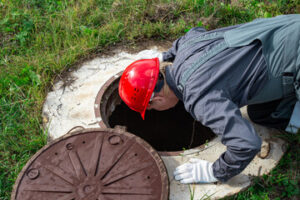Septic Tank Cleaning Perth is important to maintaining a functional wastewater system. Regular cleaning helps prevent clogs and other problems leading to untreated wastewater and health hazards.
Using a septic tank cleaner is an excellent way to reduce foul odor, extend periods between pumping, and protect your septic system from costly repairs. However, the use of chemical septic tank cleaners is not without risk.

Whether you have a residential septic system or a commercial one, cleaning it is an essential part of maintaining the overall health and performance of your waste management system. Depending on the size of your tank and how often you use it, you may need to have it cleaned every three to five years. In addition, if you have a large number of people using the same septic system, it may need to be cleaned more frequently.
Septic tank cleaning isn’t a DIY project for several reasons, the most important being that it involves handling hazardous materials. The sludge and scum from the tank are dangerous to handle and must be disposed of properly according to local regulations. A septic system professional is trained in safe and effective handling of these materials and has the proper equipment to complete the task quickly and efficiently.
The cost of septic tank cleaning depends on the size and location of your tank, as well as any additional services that you require. On average, the cost of septic tank pumping and cleaning ranges from $300 to $500, although this can vary depending on your location. In addition to the cleaning costs, you may also need to pay for a general contractor’s overhead and markup and sales tax on materials and supplies.
If your septic tank is nearing the end of its lifespan, it’s a good idea to have it inspected for any issues that might need repair. A septic system professional can inspect the tank, leach field and drain field to identify problems that could lead to sewage backups or other issues. This inspection can save you money in the long run by preventing costly repairs down the road.
Septic tank cleaning can help extend the life of your septic system. It is also an important step in keeping your home clean and healthy, as it removes solid waste that can build up over time and cause blockages in your drains. To prevent septic system problems, make sure to have your tank pumped and inspected on a regular basis, following the recommended schedule from your septic system professional. Additionally, never flush cat litter, coffee grounds, diapers, tampons, towels (even the “flushable” kind), cigarette butts, grease, dental floss, hair or other oils, chemicals, medications, or household cleaners into your septic system.
Septic systems are vital parts of a home’s wastewater treatment system, and regular maintenance and cleaning of the tanks is necessary to ensure that they function properly. Without this, a septic system can become clogged, causing water backups and flooding and releasing untreated waste into the environment. This can lead to health issues, including gastrointestinal diseases like diarrhea, as well as contaminate groundwater and nearby water sources. In addition to bacterial and chemical pollutants, septic tank failures can also lead to the release of parasitic worms.
The primary reason why septic tanks need to be pumped and cleaned regularly is because they fill up with sludge over time. This sludge is comprised of solid and liquid waste that can’t be broken down by microbes in the tank. As a result, it’s important to have your septic tank pumped and cleaned at least every three to five years to prevent overflowing and water contamination.
Another reason why septic tank cleaning is important is because it can help reduce the risk of damage to the drain field. The drain field is where the liquid waste flows into the soil after it leaves the septic tank. The septic system’s drain field must be located at least 100 feet away from any bodies of water to avoid contamination.
In addition to septic tank cleaning, there are several ways homeowners can help protect their drain fields. This includes avoiding flushing products that are difficult to break down, such as feminine hygiene products, baby wipes, paper towels, and dental floss. It is also important to conserve water and take steps to recycle as much as possible.
Another way to help the septic system is by using biological additives. These chemicals introduce billions of bacteria and enzymes into the septic system to aid in the liquefying process. By doing so, this helps prevent septic tank pollution and increases the longevity of your septic system. This is especially helpful if you have a septic tank that is over 10 years old. Additionally, you should keep small children and pets away from septic tanks because they could get tangled up in the sludge.
A septic tank is a large container buried underground that treats wastewater that flows from a home. Sludge and scum layers build up over time, making it necessary to clean the tank on a regular basis. Cleaning is done by removing the lid and pumping out the contents. It’s also important to inspect the septic system regularly for leaks and other problems.
Cleaning a septic tank can be dangerous for untrained individuals, so it’s best left to professionals with special equipment and training. Proper safety measures should be taken before the job begins, such as ensuring all gas and electrical systems are turned off and that the septic tank is well-ventilated. Workers should also wear proper personal protective equipment to ensure they don’t get contaminated with hazardous waste materials.
Septic tanks can contain harmful microorganisms, including bacteria, that are responsible for a variety of health conditions. Exposure to these microorganisms can lead to hepatitis, shigellosis, gastroenteritis, and other illnesses. Septic tank cleaning companies can help minimize the risk of exposure by using proper disinfecting techniques and by thoroughly washing their hands before removing the lid from the septic tank.
It’s also important to take precautions when using the household plumbing, as many chemicals can harm the septic tank and cause problems. Avoid flushing non-biodegradable items like wipes, diapers, cigarette butts, or paint waste down the drain, and use caustic drain cleaners sparingly. Instead, try using natural cleaners like baking soda and vinegar to keep your septic system working properly.
The septic tank system depends on ‘friendly’ bacteria to break down solid waste, but these bacteria can be killed by harsh disinfectants and bleaches. Eliminating these harmful chemicals will allow the septic tank to work more efficiently and reduce the need for routine cleaning and repair.
Another way to protect the septic system is by practicing water conservation, including using low-flow toilets and taking shorter showers. Also, limit the use of garbage disposals, which can fill the septic tank with food waste and require more frequent pumping.
Using septic tank cleaners can damage your system by killing the friendly bacteria. They can also damage your pipes and septic tank, as well as the surrounding environment. Some chemicals found in these products can even be harmful to people and pets. Instead of these chemical-based products, try using household items like baking soda and vinegar to clean your drains. This is safer for the septic system and is much cheaper than purchasing expensive septic tank cleaning chemicals.
The septic tank serves as a settling basin where solid waste is broken down through natural bacterial decomposition. Heavy masses sink to the bottom, and light masses (like fats and oils) float on top and form a semi-solid scum layer. If these solids flow into the drainage field, they can clog pipes and prevent water from exiting the septic tank properly.
All of the wastewater that leaves your home enters the septic tank through one main pipe. The inlet and outlet tees extend into the water and into the scum layer, so the hydraulic pressure of the wastewater will force it up and out through the tees and into the absorption field. However, if the septic tank reaches its maximum capacity, the sludge and scum layers can flow out into the absorption field with the wastewater, clogging the drainage pipes and contaminating nearby waterways with pathogenic bacteria, excess nutrients and other pollutants.
In these cases, the septic tank needs to be pumped out before the sludge and scum levels are too high. Using a truck with special equipment, technicians insert a large hose into the manhole and vacuum the contents of the septic tank. The septic tank is then pumped into a large tanker truck, which pumps it to a treatment plant for disposal.
An alternative to septic tank pumping is an aerobic treatment system, which uses an air pump to introduce oxygen into the tank and speed up the natural bacterial decomposition of the effluent. This process also helps to reduce the amount of ammonia discharged into receiving waters.
Another alternative septic system is the gravel/stone drainfield, which involves pipes that carry effluent to a trench filled with gravel and covered by a geofabric or similar material. The effluent then seeps through the gravel and into the soil, where it is treated by microbes once again. These systems are suitable for small lots, lots with poor soil conditions, and lots near bodies of water that require special protection against pollution.


